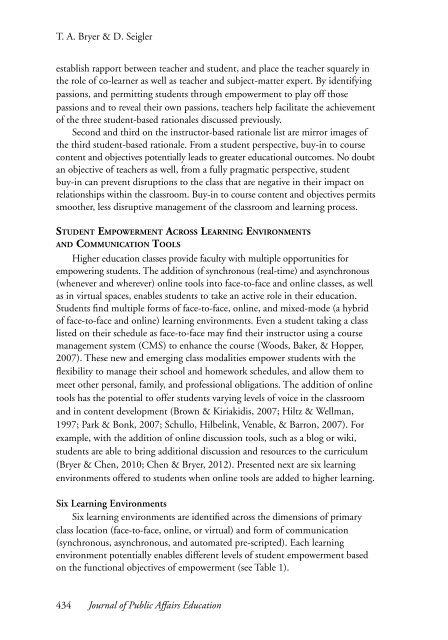summer 2012 - National Association of Schools of Public Affairs and ...
summer 2012 - National Association of Schools of Public Affairs and ...
summer 2012 - National Association of Schools of Public Affairs and ...
You also want an ePaper? Increase the reach of your titles
YUMPU automatically turns print PDFs into web optimized ePapers that Google loves.
T. A. Bryer & D. Seigler<br />
establish rapport between teacher <strong>and</strong> student, <strong>and</strong> place the teacher squarely in<br />
the role <strong>of</strong> co-learner as well as teacher <strong>and</strong> subject-matter expert. By identifying<br />
passions, <strong>and</strong> permitting students through empowerment to play <strong>of</strong>f those<br />
passions <strong>and</strong> to reveal their own passions, teachers help facilitate the achievement<br />
<strong>of</strong> the three student-based rationales discussed previously.<br />
Second <strong>and</strong> third on the instructor-based rationale list are mirror images <strong>of</strong><br />
the third student-based rationale. From a student perspective, buy-in to course<br />
content <strong>and</strong> objectives potentially leads to greater educational outcomes. No doubt<br />
an objective <strong>of</strong> teachers as well, from a fully pragmatic perspective, student<br />
buy-in can prevent disruptions to the class that are negative in their impact on<br />
relationships within the classroom. Buy-in to course content <strong>and</strong> objectives permits<br />
smoother, less disruptive management <strong>of</strong> the classroom <strong>and</strong> learning process.<br />
Student Empowerment Across Learning Environments<br />
<strong>and</strong> Communication Tools<br />
Higher education classes provide faculty with multiple opportunities for<br />
empowering students. The addition <strong>of</strong> synchronous (real-time) <strong>and</strong> asynchronous<br />
(whenever <strong>and</strong> wherever) online tools into face-to-face <strong>and</strong> online classes, as well<br />
as in virtual spaces, enables students to take an active role in their education.<br />
Students find multiple forms <strong>of</strong> face-to-face, online, <strong>and</strong> mixed-mode (a hybrid<br />
<strong>of</strong> face-to-face <strong>and</strong> online) learning environments. Even a student taking a class<br />
listed on their schedule as face-to-face may find their instructor using a course<br />
management system (CMS) to enhance the course (Woods, Baker, & Hopper,<br />
2007). These new <strong>and</strong> emerging class modalities empower students with the<br />
flexibility to manage their school <strong>and</strong> homework schedules, <strong>and</strong> allow them to<br />
meet other personal, family, <strong>and</strong> pr<strong>of</strong>essional obligations. The addition <strong>of</strong> online<br />
tools has the potential to <strong>of</strong>fer students varying levels <strong>of</strong> voice in the classroom<br />
<strong>and</strong> in content development (Brown & Kiriakidis, 2007; Hiltz & Wellman,<br />
1997; Park & Bonk, 2007; Schullo, Hilbelink, Venable, & Barron, 2007). For<br />
example, with the addition <strong>of</strong> online discussion tools, such as a blog or wiki,<br />
students are able to bring additional discussion <strong>and</strong> resources to the curriculum<br />
(Bryer & Chen, 2010; Chen & Bryer, <strong>2012</strong>). Presented next are six learning<br />
environments <strong>of</strong>fered to students when online tools are added to higher learning.<br />
Six Learning Environments<br />
Six learning environments are identified across the dimensions <strong>of</strong> primary<br />
class location (face-to-face, online, or virtual) <strong>and</strong> form <strong>of</strong> communication<br />
(synchronous, asynchronous, <strong>and</strong> automated pre-scripted). Each learning<br />
environment potentially enables different levels <strong>of</strong> student empowerment based<br />
on the functional objectives <strong>of</strong> empowerment (see Table 1).<br />
434 Journal <strong>of</strong> <strong>Public</strong> <strong>Affairs</strong> Education

















